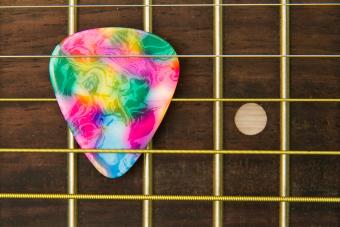
Many people find themselves looking for a diagram of an acoustic guitar so they can better understand the parts of their instrument. It is especially useful knowledge to have when you're shopping for an acoustic guitar or figuring out who makes the best acoustics. After all, what good is paying more for a certain type of bridge if you don't know how it can benefit you?
Diagram of an Acoustic Guitar: What Goes Where
The acoustic guitar is composed of two different guitar parts: the neck and the body.
Neck

The neck of the guitar is the long part of the guitar that holds the strings. There are two main parts to the neck: the actual neck itself and the head (called either the head or the headstock). The neck itself consists of the fretboard which has a certain number of frets on it (depending on which type of guitar and model). There is a white nut at the top of the fretboard between the neck and the head. This nut helps keep the strings in place and pulled taut down the fretboard neck. The strings are tied into the head by tuning pegs (often called machine heads). These pieces of metal wind the strings around themselves and are used to affix the strings to the head piece. They are also used when trying to tune an acoustic guitar. They can be turned to loosen or tighten a string.
Body
The body of the guitar is the large part of the guitar that restss against your body as you play. The empty hole that the strings lay over is called the sound hole. The size of the sound hole can differ depending on the type of guitar and model. The strings ring through the sound hole, and it actually controls the treble or bass tones the guitar makes. The bridge of the guitar is just below the sound hole. The bridge attaches the strings to the body of the guitar and are important to the tonal quality of the guitar. The quality and sound of the bridge is often dependent on the type of wood that is used. Similar to the nut on the neck, the saddle is the part of the guitar that strings lay over on the body. It is located below the sound hole on the bridge.
Value of Learning the Parts of an Acoustic Guitar
To some players, memorizing the parts of the guitar might seem tedious. However, doing so can actually help your music exponentially in numerous ways:
- If you know how the parts of your guitar work, you can produce a better sound. For example, if you know that your sound hole produces a stronger bass sound than treble sound, you can compensate for it slightly through your playing technique.
- Knowing the parts of the guitar can help you when purchasing a new guitar. You can haggle for a better price, for example, if you know that the wood used in the bridge of the guitar you are looking at will produce a lesser quality tone than another.
- Knowledge of the parts of your guitar lends itself to spending less money on minor repairs. Why? If you know a little bit about how things work, you can likely fix them yourself instead of having to bring your guitar into the shop. Simple things like restringing the guitar or adjusting the bridge pins can be taken care of by your own knowledgeable hand.
Getting to Know Your Guitar
Perhaps the biggest benefit of learning the names of all the parts on your guitar is the knowledge that you are gaining about your own personal instrument. This can certainly help make playing more enjoyable.







